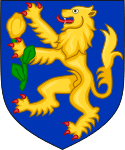County of Santa Fiora
| County of Santa Fiora | |||||
| Contea di Santa Fiora | |||||
| |||||
|
| |||||
 Italy in 1499 | |||||
| Capital | Santa Fiora | ||||
| Languages | Tuscan, Latin, Italian | ||||
| Government | Absolute Monarchy (County) | ||||
| History | |||||
| • | Established | 1274 | |||
| • | Disestablished | 1806 (in 1633 as sovereign County) | |||
The County of Santa Fiora (Italian: Contea di Santa Fiora), also known as State of Santa Fiora (Italian: Stato di Santa Fiora)[1] was a small historical state of southern Tuscany, in central Italy. Together with the county of Sovana, it was one of the two subdivisions into which the possessions of the Aldobrandeschi, then lords of much of southern Tuscany, were split in 1274.
At the moments of its creation it included part of today's province of Grosseto, up to the Isola del Giglio, and Castiglione d'Orcia, in what is now the province of Siena. In the 14th century the Republic of Siena was able to capture Isola del Giglio, Roccastrada, Istia d'Ombrone, Magliano in Toscana, Selvena, Arcidosso and Castiglione d'Orcia, reducing the county to its capital, Castell'Azzara, Semproniano and Scansano.
In 1439, after the marriage of Bosio I Sforza and the last Aldobrandeschi heir, Cecilia, the county was inherited by the Sforza family, who would become ruler of the Duchy of Milan and owned also other possessions in Tuscany and the Marche.
The sovereignty of the County was ceded to the Grand Duchy of Tuscany in 1633.[2]
References
- ↑ "Sforza", in Nuova Enciclopedia Popolare Italiana, vol. XXI, Turin, 1865
- ↑ "Sforza", in Gaetano Moroni, Dizionario di erudizione storico-ecclesiastica da S. Pietro sino ai nostri, vol. LXV, Tipografia Emiliana, Venezia 1854
- Guerrini, Giuseppe (1999). Torri e Castelli della Provincia di Grosseto. Siena: Nuova Immagine Editrice.
- Monaci, Francesca (2010). Santa Fiora nella storia: La comunità e gli Sforza negli Statuti del 1613. Arcidosso (GR): Edizioni Effigi.
